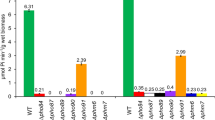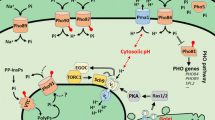Abstract.
In this study we have used a newly isolated Yarrowia lipolytica yeast strain with a unique capacity to grow over a wide pH range (3.5–10.5), which makes it an excellent model system for studying H+- and Na+-coupled phosphate transport systems. Even at extreme growth conditions (low concentrations of extracellular phosphate, alkaline pH values) Y. lipolytica preserved tightly-coupled mitochondria with the fully competent respiratory chain containing three points of energy conservation. This was demonstrated for the first time for cells grown at pH 9.5–10.0. In cells grown at pH 4.5, inorganic phosphate (Pi) was accumulated by two kinetically discrete H+/Pi-cotransport systems. The low-affinity system is most likely constitutively expressed and operates at high Pi concentrations. The high-affinity system, subjected to regulation by both extracellular Pi availability and intracellular polyphosphate stores, is mobilized during Pi-starvation. In cells grown at pH 9.5–10, Pi uptake is mediated by several kinetically discrete Na+-dependent systems that are specifically activated by Na+ ions and insensitive to the protonophore CCCP. One of these, a low-affinity transporter operative at high Pi concentrations is kinetically characterized here for the first time. The other two, high-affinity, high-capacity systems, are derepressible and functional during Pi-starvation and appear to be controlled by extracellular Pi. They represent the first examples of high-capacity, Na+-driven Pi transport systems in an organism belonging to neither the animal nor bacterial kingdoms. The contribution of the H+- and Na+-coupled Pi transport systems in Y. lipolytica cells grown at different pH values was quantified. In cells grown at pH values of 4.5 and 6.0, the H+-coupled Pi transport systems are predominant. The contribution of the Na+/Pi cotransport systems to the total cellular Pi uptake activity is progressively increased with increasing pH, reaching its maximum at pH 9 and higher.
Similar content being viewed by others
Author information
Authors and Affiliations
Additional information
Received: 15 December 2000/Revised: 14 May 2001
Rights and permissions
About this article
Cite this article
Zvyagilskaya, R., Parchomenko, O., Abramova, N. et al. Proton- and Sodium-Coupled Phosphate Transport Systems and Energy Status of Yarrowia lipolytica Cells Grown in Acidic and Alkaline Conditions. J. Membrane Biol. 183, 39–50 (2001). https://doi.org/10.1007/s00232-001-0054-9
Issue Date:
DOI: https://doi.org/10.1007/s00232-001-0054-9




